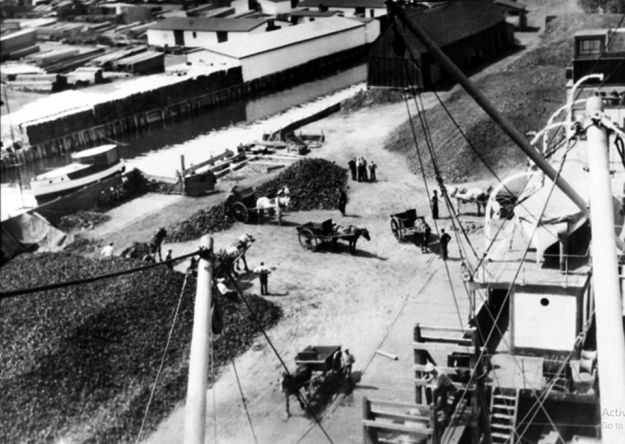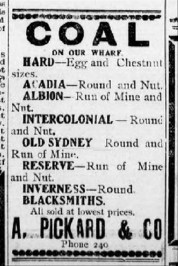
Waterfront coal yard, probably A. Pickard & Co. ca. 1913. Photo from Keystone Mast Collection, University of California at Riverside.
While agricultural produce including livestock was probably the most frequently exported commodity at the Charlottetown wharves at the beginning to the 20th century, the incoming volume was dominated by coal. The number of shipments up to the mid-19th century was small. Heat for houses and businesses was supplied by firewood brought down the rivers by small schooners in summer and on sleighs across the ice in winter. What coal there was, was used for heat in a few upper-class homes but primarily to fire forges of blacksmiths in both rural and city establishments. Every shipyard needed forged iron fittings and although some coal was delivered directly to outports much came first to Charlottetown.
That began to change as steamboats started to visit the port. Unlike American inland steamers which depended on wood most of the early boats serving PEI had coal-fired boilers. Coal was most easily accessed at the Pictou end of the route which was close to the mines of the General Mining Association. But after 1854 coal began to be imported in large quantities. In that year the Charlottetown Gas Light Company opened its plant at the eastern edge of the city. Over the next half-century coal was turned into gas and pumped through the mains laid beneath the streets to houses, streetlights and business across the city.
Even when the domination of gas was challenged, and eventually, replaced by electricity the dependency on coal did not change. The steam generators and dynamos in the several electric plants all used coal and even when the companies were amalgamated and centralized on the gas works property it was still coal that provided the power.

Large’s Coal Yard. Connolly’s wharf ca. 1930. Photo PARO Accession 2320 18-16
The other big coal consumer was the Prince Edward Island Railway. Its steam engines continued to be coal-fired until the province became the first part of the Canadian National Railway System to be entirely diesel-powered in 1949. While the railway carried coal to small communities across the Island and took some business away from small coal schooners visiting outlying ports the coal cars meant that even more coal came into the province through the port of Charlottetown.
In 1856, seizing on its new powers after incorporation the City of Charlottetown enacted a by-law to create coal-meters and weighers who had the responsibility of weighing all coal sold in the city, whether directly from a ship or from a wharf or coal yard. The city scales was moved from the head of Pownal Wharf to Queens Square to underscore the growing importance of coal in the city. Besides providing a consumer service the coal distribution oversight provided revenue for the city.
 At first almost all of the many wholesale merchants handled coal as one of their commodities, but by the beginning of the Great War it was becoming more specialized. Buntain and Bell took over the coal and shipping business of Peak Bros. in 1913, along with the wharf near the foot of Queen Street which became known through to the 1960s as the Buntain and Bell Wharf. Several of the wharves became almost exclusively coal wharves. George E. Full’s Coal Yard was on the old Duncan property next to the ferry wharf. A. Pickard and Company was located on what had been the Plant Line Wharf and was one of the last to be in operation into the 1960s. Another coal merchant in the early 20th century was Charles Lyon and in mid-century W.D. Gillis, Arnfast Coal Company and the Weeks Coal Company were in operation, the latter near the Hillsborough Bridge. Some of the companies erected large sheds to protect the coal from the weather but most of the coal was simply stored in large heaps. The coal wharves were black, dirty, dusty places. Most of the loading and unloading was by men with shovels with the coal carried through the streets by small horse-drawn tip-carts.
At first almost all of the many wholesale merchants handled coal as one of their commodities, but by the beginning of the Great War it was becoming more specialized. Buntain and Bell took over the coal and shipping business of Peak Bros. in 1913, along with the wharf near the foot of Queen Street which became known through to the 1960s as the Buntain and Bell Wharf. Several of the wharves became almost exclusively coal wharves. George E. Full’s Coal Yard was on the old Duncan property next to the ferry wharf. A. Pickard and Company was located on what had been the Plant Line Wharf and was one of the last to be in operation into the 1960s. Another coal merchant in the early 20th century was Charles Lyon and in mid-century W.D. Gillis, Arnfast Coal Company and the Weeks Coal Company were in operation, the latter near the Hillsborough Bridge. Some of the companies erected large sheds to protect the coal from the weather but most of the coal was simply stored in large heaps. The coal wharves were black, dirty, dusty places. Most of the loading and unloading was by men with shovels with the coal carried through the streets by small horse-drawn tip-carts.
The photo of the beginning of this piece shows that coal was an intensely manual activity (at least in 1913 when the photo was taken) but some companies tried to keep up with modern technology. A puff piece in the Charlottetown Guardian in 1930 touted A. Pickard & Co.’s 7 1/2 horsepower electric conveyor which could load coal at the rate of a ton a minute! [surely this must be per hour?] Their wharf (now buried under the massive DOT wharf east of the yacht club) could accommodate vessels up to 3000 tons and had a 300 foot rail siding which held eight rail cars. At the time the Pickard firm was handling Scotch, Welsh, and American Anthracite Coal as well as Dominion Coke, Old Sydney, Inverness, Acadia and Springhill Coal. Coal was delivered to consumers by 20 horse teams and carts. Conscious of the public image the article noted “The neat and clean appearance of the Yard and Wharf show that the workmen are good men and are taking an interest in their work.”
The persistence of newspaper advertising shows this was a competitive business and it was not long before there were only a few companies that had the wharfage to support the shipping requirements. After the Second World War coal was a declining business on P.E.I.. Home heating as well as industrial users such as Maritime Electric were switching petroleum fuels and the coal years on the wharves were displaced by huge oil storage tanks.
Coal advertisements from 1913-1953 (click for enlargement & slide show)
Few city residents visited the actual waterfront yards. The remaining firms had uptown storefronts. I can remember passing Arnfast’s display of dusty Blue Coal in the window of their shop on Great George Street across from the Capitol Theatre. Within a generation the coal business as a waterfront activity disappeared and disappearing with it was the particular coal vocabulary with which everyone was once familiar. Who today can tell the difference between round, stove, egg and chestnut coal, much less the heating qualities differentiating Albion Nut from Reserve Runamine or from Old Sydney Round? The closing of the coal yards was one of the last activities on the waterfront before the revitalization of the area by the Charlottetown Area Development Corporation in the 1970s.







Superb post. Thank you for shedding some light on a part of history that I’m keen on but can find little information on.
I’m keen to learn more about the role the railway played in the distribution of coal on the Island. Thanks to the newspaper archive (islandnewspapers.ca) I’ve found several examples from the mid-1950’s of railway car loads of coal being sold, by the carload, at places like Mount Herbert or Vernon River. As I piece together some sense of the customer end, I haven’t been as lucky with understanding how the coal got to the Island or how it was distributed (for example: did the mine have agents or were these carloads bought and sold by individuals trying to earn a little extra income during a long winter?)
Thanks again for the post. I enjoy following your blog.
Chris
Pingback: Memories of the Charlottetown waterfront in the 1840s | Sailstrait
Pingback: Fred Small’s Yacht Club photos | Sailstrait
solar energy consumption
Pingback: A Harbour Full of Sails | Sailstrait
Pingback: James Duncan – Charlottetown’s Biggest Bankrupt | Sailstrait
Pingback: Postcards from the Sky: Aerial images of the Charlottetown Waterfront 1930- 2000 | Sailstrait
Pingback: Postcards from the Sky: Aerial images of the Charlottetown Waterfront 1930-2000 – STRAITPOST
Pingback: No better way to know Charlottetown… | Sailstrait
This was a wonderful story as I lived 2 streets away from Pickards coal yard ,in fact as a boy we had coal and coke delived to our home on King St by horse drawn wagon in summer and sled in winter. We spend a great deal of our youth at the water front both at Pickards and the city barns next door. Ships were comming and going all the time. Thank you for the story.